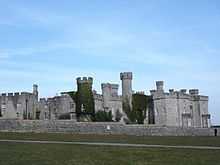Bodelwyddan Castle

Bodelwyddan Castle, close to the village of Bodelwyddan, near Rhyl, Denbighshire in Wales, was built around 1460 by the Humphreys family of Anglesey as a manor house. Its most important association was with the Williams-Wynn family, which extended for around 200 years from 1690. It is now a Grade II* Listed Building.[1]
History

The castle was bought from the Humphreys by Sir William Williams, Speaker in the House of Commons from 1680-1681.[2] The castle which stands today was reconstructed between 1830 and 1832 by Sir John Hay Williams, who employed the architects Joseph Hansom (inventor of the Hansom cab) and Edward Welch to refurbish and extend the house.[3] The Williams' family fortunes started to decline in the 1850s, due to the loss of the main source of income for the estate, lead mining. The castle has been described as one of Hansom's most ambitious projects, "being wildly dramatic and owing nothing to its predecessors".[4] At the same time works were carried out to construct an estate wall and formal gardens.
Further refurbishment work was carried out in the 1880s by Sir Herbert, 7th Baronet, who inherited Bodelwyddan Castle from his heirless cousin.By the First World War the house had become a recuperation hospital for wounded soldiers. During this time, the grounds of the estate were used by soldiers based at the nearby Kinmel Camp for trench warfare training.[5] Traces of these trenches can still be seen.
By 1920, the cost of maintaining the castle and estate had grown too burdensome, and the Williams-Wynn family leased Bodelwyddlan to Lowther College, a girls private school.
Lowther College
In 1920, the house became a private school for girls, Lowther College. The school was formed in 1896 at Lytham St. Annes in Lancashire, by Mrs Florence Morris (later Lindley).[6] The school originally moved to Bodelwyddan as tenants of the Williams family, however Lowther College purchased the property five years later, in 1925.[4]
The school is thought to be one of the first private schools for girls to have its own swimming pool. It also had a private golf course. The Lowther College Tableaux were well regarded within the community for their musical excellence.
Boys were admitted from 1977. The school closed in 1982 due to financial problems.[7]
Museum and Arts Centre
In the 1980s, the site was bought by Clwyd County Council with the aim of developing the castle as a visitor attraction. Partnerships were formed with several prominent museums and art galleries, such as the National Portrait Gallery and the Royal Academy of Arts, so that the castle could be used to display objects from these collections. In order to house these items, the interior of the castle was restored by Roderick Gradidge, an expert on Victorian architecture.
Part of the site was leased to the Rank Organisation in 1994 for development into a luxury hotel, Bodelwyddan Castle Hotel,[8] and this use remains today. The historic house and grounds are not part of the hotel but are managed by an independent trust and are open to the public.
Ghosts
There have been many reports of ghost sightings at the castle, including that of a soldier in one of the galleries. Sir John Hay Williams wrote in 1829 that, during a period of refurbishment, human bones were found near one of the chimneys. They were built back into the wall, which means they remain there to this day. The castle has also been the subject of two episodes of Living TV's Most Haunted[9] and Syfy's Ghost Hunters International.
Gardens
The castle is set within a large area of parkland, and formal gardens, the most recent of which was originally designed by Thomas Hayton Mawson in 1910.[10]
The castle structure seen today is mostly a Victorian facade, but that covers a core that is believed to date back to the 13th century. Archaeologists have found Roman remains on the site, and suspect they relate to a settlement adjacent to the nearby Roman road.
The castle has a distant view of Rhuddlan Castle and St. Asaph Cathedral—which was damaged in the 15th century by both the English armies and the Welsh Owain Glyndŵr's forces. However, the Bishop was sympathetic to Owain's men, whilst he excommunicated the English.
See also
References
- ↑ Caring for Our Built Heritage: Conservation in Practise; Tony Haskell, 1993, p.133
- ↑ "Bodelwyddan Castle Introduction". National Portrait Gallery. Retrieved 2007-12-01.
- ↑ Harris, Penelope, "The Architectural Achievement of Joseph Aloysius Hansom (1803-1882)", The Edwin Mellen Press, 2010, ISBN 0-7734-3851-3.
- ↑ 4.0 4.1 Tony Haskell, Ibid., p.133
- ↑ "Trenches". Bodelwyddan Castle. Retrieved 2007-12-01.
- ↑ "Lowther College". Archives Network Wales. Retrieved 2007-12-01.
- ↑ "Lowther College". Bodelwyddan Castle. Archived from the original on 2007-11-08. Retrieved 2007-12-01.
- ↑ "History". Bodelwyddan Castle. Archived from the original on 2007-11-08. Retrieved 2007-12-01.
- ↑ "Ghosts". Bodelwyddan Castle. Retrieved 2007-12-01.
- ↑ "gardens". Bodelwyddan Castle. Archived from the original on 2007-11-08. Retrieved 2007-12-01.
External links
- Bodelwyddan Castle - official site
- Photos
- National Portrait Gallery
Coordinates: 53°15′40″N 03°30′06″W / 53.26111°N 3.50167°W